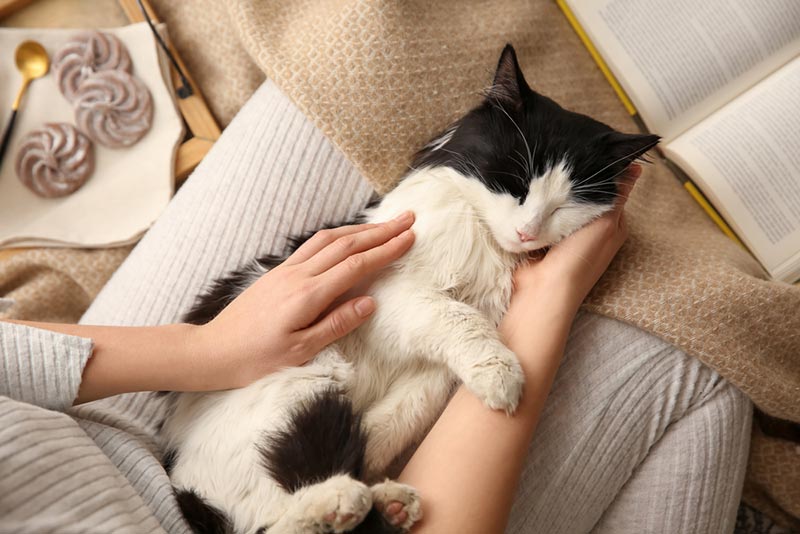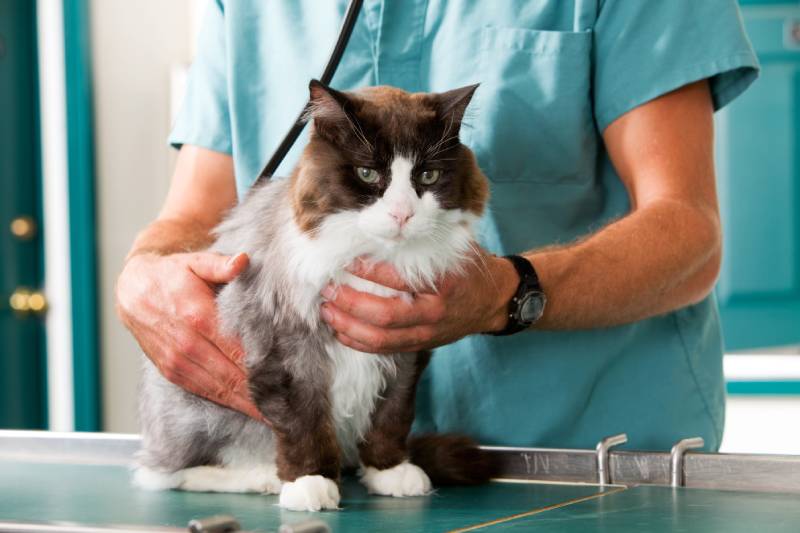How Much Does a Russian Blue Cat Cost? 2024 Price Guide

Updated on
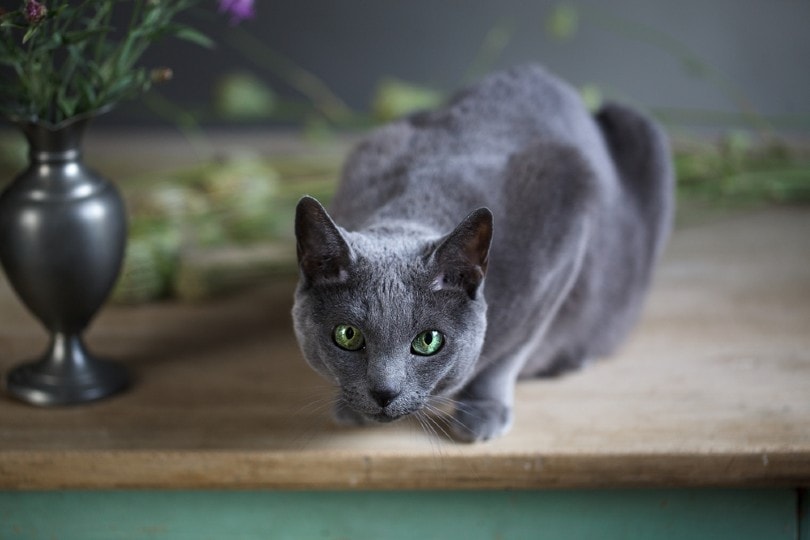
Click to Skip Ahead
The Russian Blue is a popular cat breed due to its combination of intelligence, affection, and easy-going nature. If you’ve been thinking about adding a sweet Russian Blue to your family, then the first thing to do is consider the costs of cat ownership.
Knowing roughly how much you’re going to need for initial one-off expenses and ongoing monthly costs will give you a better idea of how you can absorb these costs into your budget. Certain services, like veterinary care, will vary from region to region, but essentials like food and cat litter can typically be found at fairly consistent prices.
If you’re ready to know how much it’s going to cost you to keep a gorgeous Russian Blue, we’re here to tell you everything that you need to know.
Bringing Home a New Russian Blue Cat: One-Time Costs
Becoming a cat owner for the first time requires a fair amount of upfront investment in supplies for your new kitty. If you’ve owned cats before, then you can save costs by reusing supplies that you already have.
Besides the initial supplies that your new kitten will need, you’ll also have to factor in their healthcare procedures, including vaccinations, microchips, and spaying or neutering when they’re old enough. Let’s first take a look at how much you should budget for a kitten.
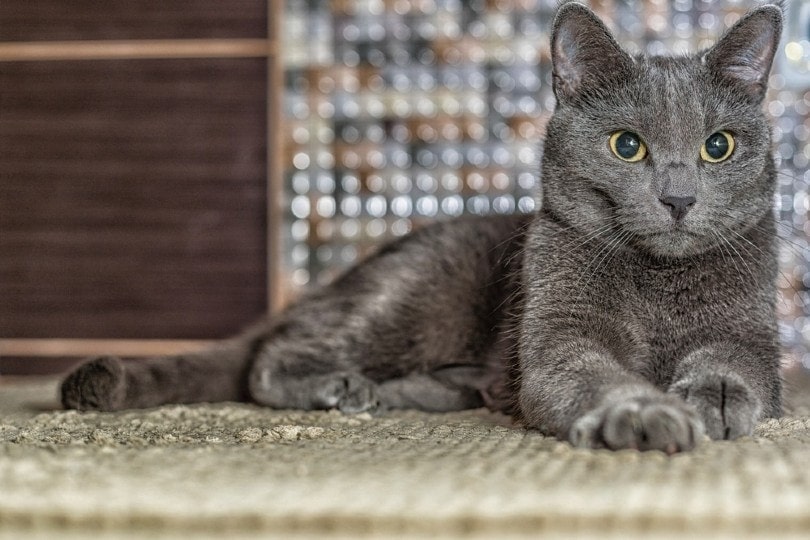
Free
You may sometimes see ads for free kittens. These are likely from accidental litters and won’t be purebred Russian Blues. It’s unlikely that they’ll have had any significant health checks. Remember that the initial cost of your kitten will end up being much less than the amount that you spend on them throughout their lifetime. While a free kitten may look like a bargain, it’s usually better to adopt a kitten from a shelter or buy one from an approved breeder.
Adoption
$100–$250
You may sometimes find an adult Russian Blue that’s been surrendered to a shelter through no fault of its own or even a litter of kittens. They may not have papers from a breed registration, but if you don’t mind that, then a shelter is a great place to find your new cat and give them a loving forever home. All shelters will check the health of any cat before they’re put up for adoption. While you may have to pay a fee, this covers any vet checks that your new cat has had and goes toward the costs of keeping the shelter running to help more cats in need.
Breeder
$400–$1,000
Most Russian Blue kittens from breeders will end up costing between $400 and $1,000. You shouldn’t have any trouble finding registered breeders of Russian Blues, as they’re quite popular. It’s always worthwhile taking the time to ask each breeder a few questions so you can get a sense of their procedures.
- If you can meet both parent cats
- If it’s possible to visit the breeding facilities
- What health tests the parent cats have had
- Which breed organization the kittens will be registered with
Initial Setup and Supplies
$120–$450
The amount that you’ll need to spend on the initial supplies for your new cat or kitten will depend on if you already have any items from previous cats. We recommend investing in everything that we’ve listed here. You can shop around to find the best deals or splash out on top-quality items, whatever you prefer!
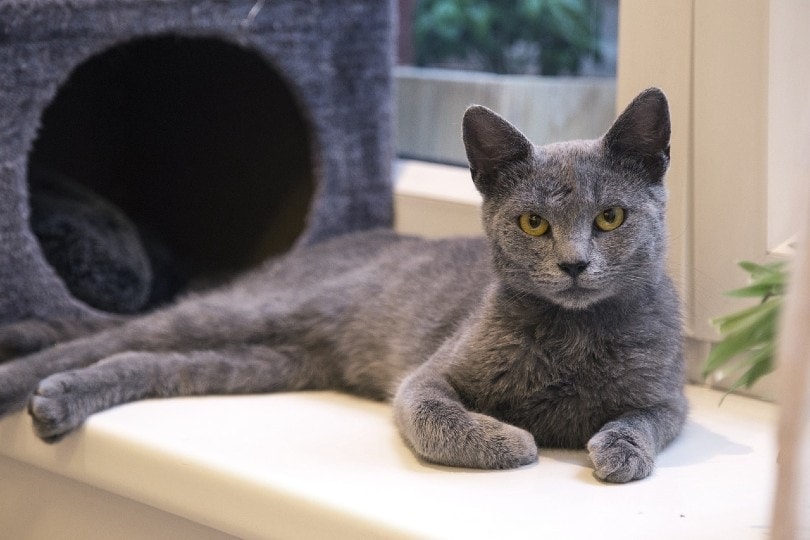
List of Russian Blue Cat Care Supplies and Costs
If you’re not sure what to buy for your new kitten or cat, we rounded up everything that we recommend. For vet care, you can ask around local vets for their prices, and for everything else, you can check out online pet supply stores.
| ID Tag and Collar | $15 |
| Spay/Neuter | $145 |
| X-ray Cost | $100–$250 |
| Ultrasound Cost | $250–$500 |
| Microchip | $45–$55 |
| Teeth Cleaning | $150–$300 |
| Bed | $30 |
| Nail Clipper | $7 |
| Brush | $8 |
| Litter Box | $25 |
| Litter Scoop | $10 |
| Toys | $30 |
| Carrier | $40 |
| Scratching Post | $50 |
| Food and Water Bowls | $10 |
How Much Does a Russian Blue Cat Cost Per Month?
$20–$250 per month
Once you’ve bought everything on this list and paid for your new kitten, you can start thinking about how much your monthly cat care costs will be. This can vary, depending on what brands of cat food and litter you decide to use. The cost of vet care, including things like monthly medication, is something else that will affect your ongoing costs.
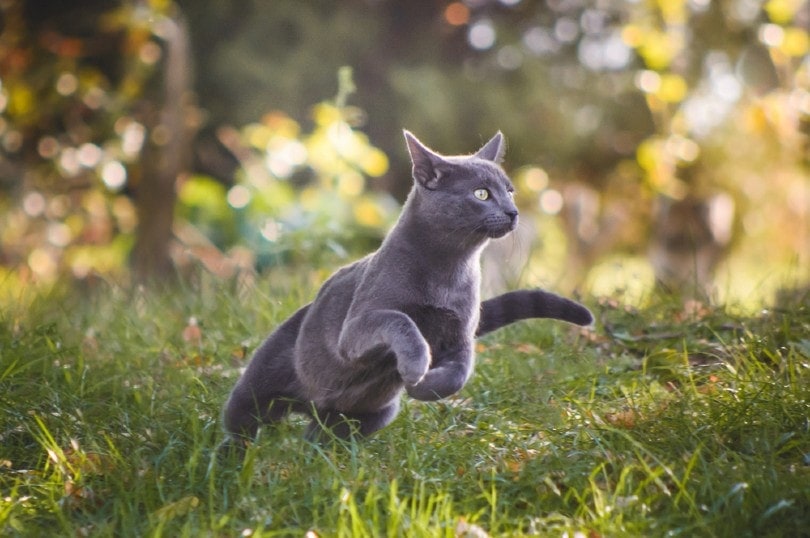
Health Care
$15–$200+ per month
- Treatment for fleas and other parasites
- Dental care, including teeth cleaning
- Vaccinations and health checks
You’ll also need to bear in mind that your cat may, at some point in their life, need emergency vet treatment. If they’ve been in an accident or eaten something poisonous, you’ll need to think about how to meet those unexpected bills. You may decide to take out pet insurance or set up a savings account. Some vets will allow for payment plans, so it’s always a good idea to ask about this possibility before you actually end up needing it.
Food
$20–$75 per month
When it comes to feeding your cat, there’s a huge range of options to choose from. Check out a few reviews, and you’ll easily find plenty of choices within your particular budget. It’s always a good idea to choose a food that has real meat as one of the first ingredients and contains plenty of protein. Luckily, there are plenty of these to choose from.
Grooming
$0–$15 per month
A Russian Blue has a plush and dense coat, but they don’t actually shed all that much. It’s a good idea to invest in a good-quality brush and give your cat a quick groom two to three times per week. This helps remove shedding hair and keeps your cat’s skin in good condition.
Medications and Vet Visits
$0–$50+ per month
As a naturally occurring breed, the Russian Blue is extremely healthy and rarely suffers from any particularly serious health conditions. If your cat does develop a condition that needs regular medication, then your monthly costs for medication and vet visits will increase as a result.
You should brush your cat’s teeth at least three times per week, to reduce the chances of them developing dental disease, something that can affect all cat breeds.
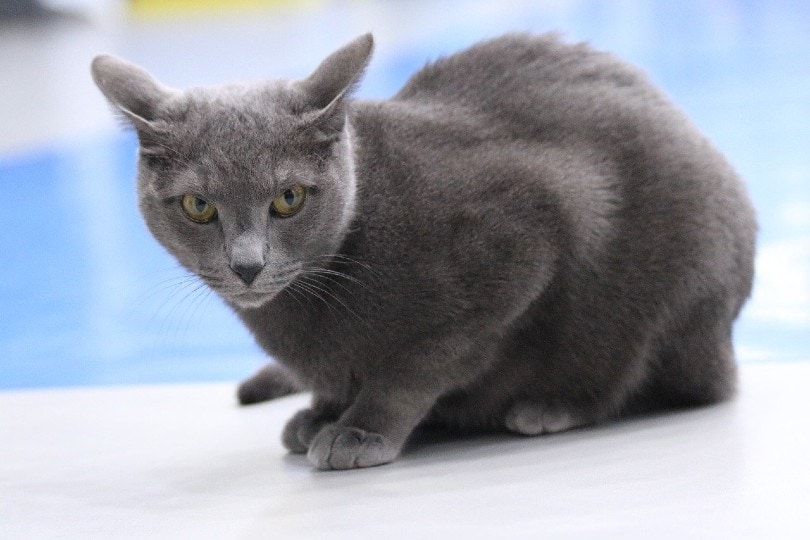
Pet Insurance
$5–$25+ per month
Taking out pet insurance isn’t essential, but if you do decide to insure your cat, it can give you the peace of mind of knowing that emergency or unexpected vet bills will be covered. It’s a good idea to take a look at a few policies to see whether any of them suit you, even if you’re not sure that you’ll take out a policy. You might find it better value than you expected.
- See also: Russian Blue Siamese Cat Mix
Environment Maintenance
$15–$100+ per month
After buying your cat’s food, environmental maintenance is usually one of the larger monthly expenses for cat owners. Typically, you’ll need 20 pounds of cat litter for each cat, each month. Some brands are cheap, while others are more expensive but last longer.
Providing extra enrichment, like a new cardboard scratcher each month, is a great way to give your cat something to sharpen its claws on and to save your furniture!
| Litter box liners | $5/month |
| Deodorizing spray or granules | $5/month |
| Cardboard scratcher | $10/month |
| Litter | $10+/month |
Entertainment
$0–$50+ per month
This category isn’t necessarily essential, and you can save quite a bit of money by not purchasing the latest toys. All cats need a stimulating environment to keep them physically and mentally happy, though. You can create this in a low-cost way by using cardboard boxes or making your own toys.
If you do want to treat your cat to new toys or treats every month, then signing up for a subscription box is a great way to keep them entertained.
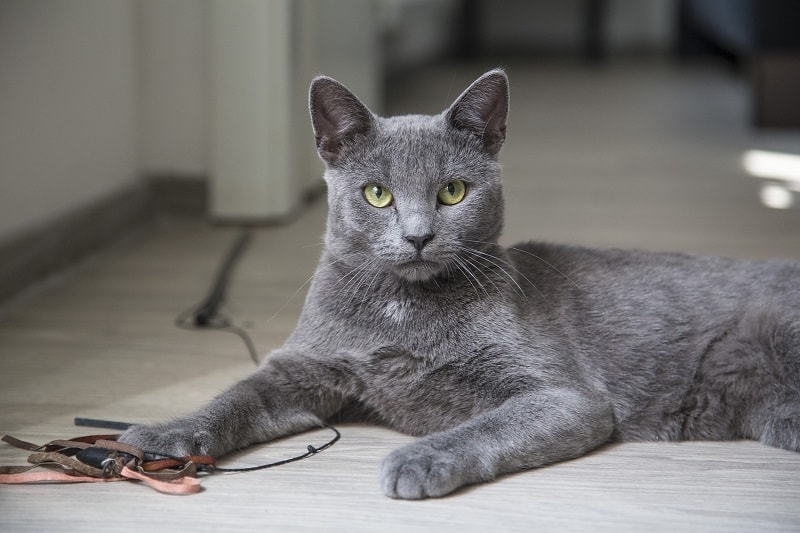
Total Monthly Cost of Owning a Russian Blue Cat
$20–$100 per month
The total monthly costs to keep your Russian Blue will depend on if you’re going to buy budget brands or spend more money on premium quality. You can blend both by buying premium food and budget cat litter.
Veterinary care is the main thing that will increase your monthly costs, so if your Russian Blue needs monthly medication or an emergency trip to the vet, your costs will increase as a result.
Additional Costs to Factor In
Besides ongoing monthly costs, it’s worth remembering that you may need to absorb occasional costs, including:
- Pet sitters when going on vacation
- Emergency treatments for illness
- Household damage caused by your enthusiastic cat
- Behavioral training
Owning a Russian Blue Cat On a Budget
If you’ve got your heart set on owning a Russian Blue, but you know that you need to stick to a certain budget, the good news is that it’s completely possible to keep a cat happy and healthy without spending a huge amount of money.
It’s always a good idea to choose high-quality cat food first and save money on everything else.
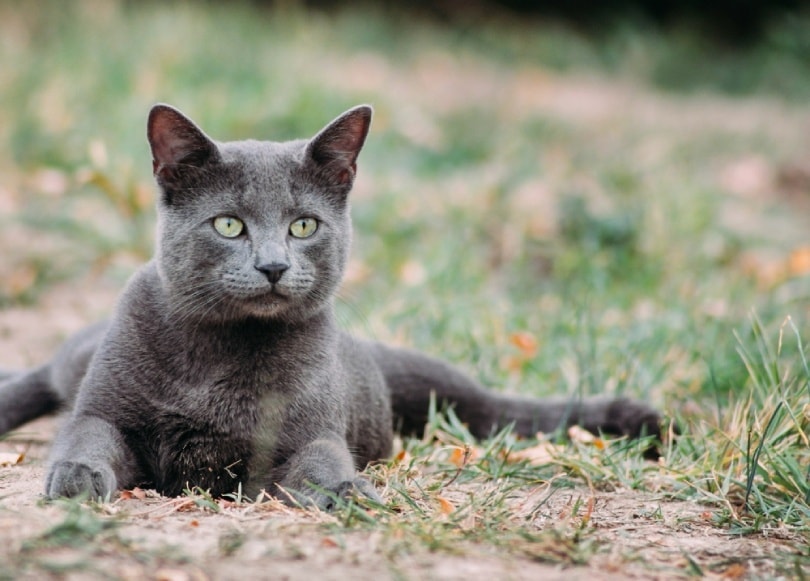
Saving Money on Russian Blue Cat Care
Rather than buying new items, ask around friends or family to see if anyone has an old cat carrier that they no longer use or bowls that they’re happy to pass along to your new cat. You can make plenty of DIY items too, including a crochet cat bed, a scratching post made from wood offcuts, or homemade toys.
What all cats want more than anything else is quality time with their owners. Taking the time to play with your cat and simply hang out with them will be worth more to your cat than all the fancy toys in the world.
Conclusion
After you’ve invested in your new Russian Blue’s initial supplies and any veterinary procedures, like spaying or neutering, your monthly costs can be as little as $25 for budget food and cat litter. While it’s fine to spend more on whatever you think your cat needs, it’s also possible to stick to a budget.
One thing that can unexpectedly cause your monthly costs to increase is unplanned veterinary care. Spending a small amount on pet insurance each month can help absorb some of these costs, as can setting aside money in an account for your cat’s care.
Taking the time to choose high-quality cat food is always sensible because this is something that can make a big difference to your cat’s health and wellbeing. What every Russian Blue will appreciate most, though, is plenty of love and attention from their new family!
Featured Image Credit: Nailia Schwarz, Shutterstock


